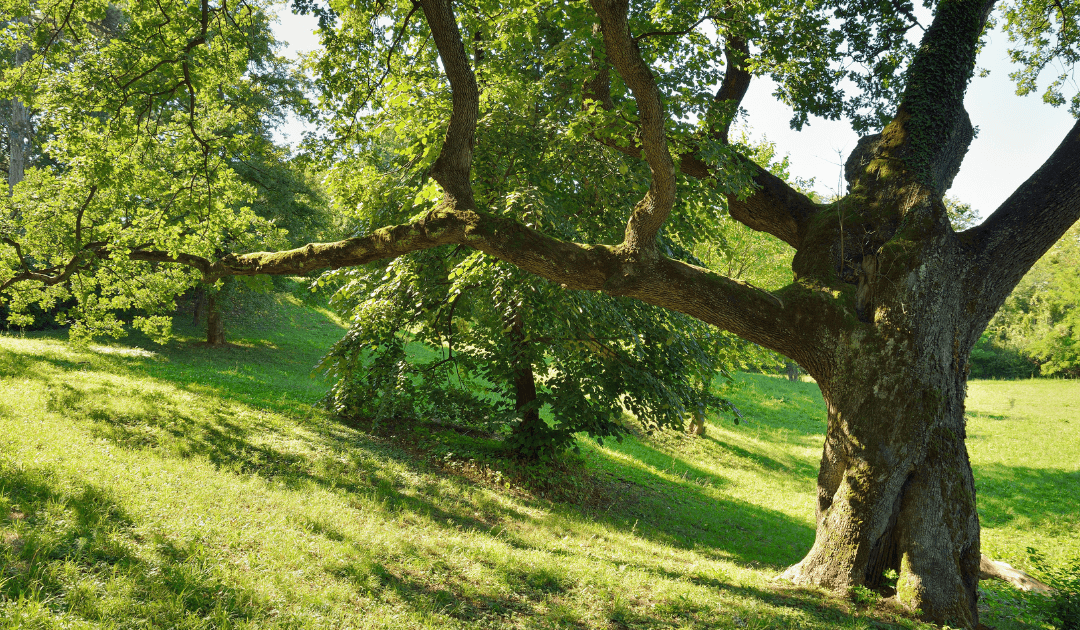Oak trees are majestic and beautiful trees that staple many landscapes. Depending on the type of oak tree, they can grow anywhere from 30 feet to over 100 feet tall. They provide shade in the hot summer months, and their leaves change colors in the fall, creating a breathtaking display of reds, oranges, and yellows. But did you know that you can classify different oak tree types based on their leaf shapes? This article will explore the various oak tree types by leaf and how to identify them.
Common Characteristics of Oak Leaves
- Shape: Oak leaves typically have lobes – projections that give the leaf a unique shape. These lobes can vary in number, size, and shape, with some being more rounded while others are more pointed. The distinct shape of oak leaves makes them easily recognizable.
- Color: A shiny dark green upper surface and a lighter green lower surface are common features of many oak tree leaves. However, the color of oak leaves can also vary depending on factors such as the species of oak and the time of year. During the autumn, oak leaves often display vibrant hues of red, orange, and yellow, adding to the natural beauty of these trees.
- Size: Oak leaves vary in size but usually fall within the range of 2 to 8 inches long. The size of oak leaves can be influenced by various factors, including the tree’s age and the growing conditions. Younger oak trees tend to produce smaller leaves, while mature oak trees can have larger and more robust leaves.
- Veins: The midvein, or the central vein, is a prominent feature in oak leaves. Secondary veins branch out from the midvein, traversing through the leaf and extending towards the lobes. The intricate vein pattern not only adds to the aesthetic appeal of oak leaves but also plays a crucial role in transporting water and nutrients throughout the leaf.
- Acorn Production: All oaks produce acorns, a key identification feature alongside leaves. Acorns are the fruit of the oak tree and serve as an important food source for wildlife. The size, shape, and color of acorns can vary among oak species, providing further clues for identifying oak trees. Observing the presence and characteristics of acorns can help distinguish one oak species from another.
Identifying Red Oak Varieties by Leaf Features
Red oaks, including the Northern Red Oak (Quercus rubra) and the Pin Oak (Quercus palustris), are distinguished by their leaf features. Their leaves often have deep sinuses and bristle-tipped lobes. The upper surface is a shiny dark green, while the lower surface may have a rusty brown hue. As the leaf matures, it turns yellowish-red, adding to the beauty of these trees.
The Northern Pin Oak (Quercus ellipsoidalis), another red oak variant, has similar leaves but with a wedge-shaped base. It’s also fast-growing compared to other oaks.
Identifying White Oak Varieties by Leaf Characteristics
White oaks like the Swamp White Oak (Quercus bicolor) and the Bur Oak (Quercus macrocarpa) have leaves with rounded lobes and a shiny green surface. The White Oak (Quercus alba) leaves turn a deep red as they mature.
The Chinkapin Oak (Quercus muehlenbergii) is another white oak species with distinctive leaf features. Its leaves are deeply cut with sharp, pointed lobes. In contrast, the Post Oak (Quercus stellata) has unique cross-shaped leaves.
Identifying oak trees by their leaves can be a fun and educational activity. However, factors like geographic location and particular species characteristics also play a role in accurate identification.
With these identification features in mind, let’s take a closer look at some common oak tree types by leaf.
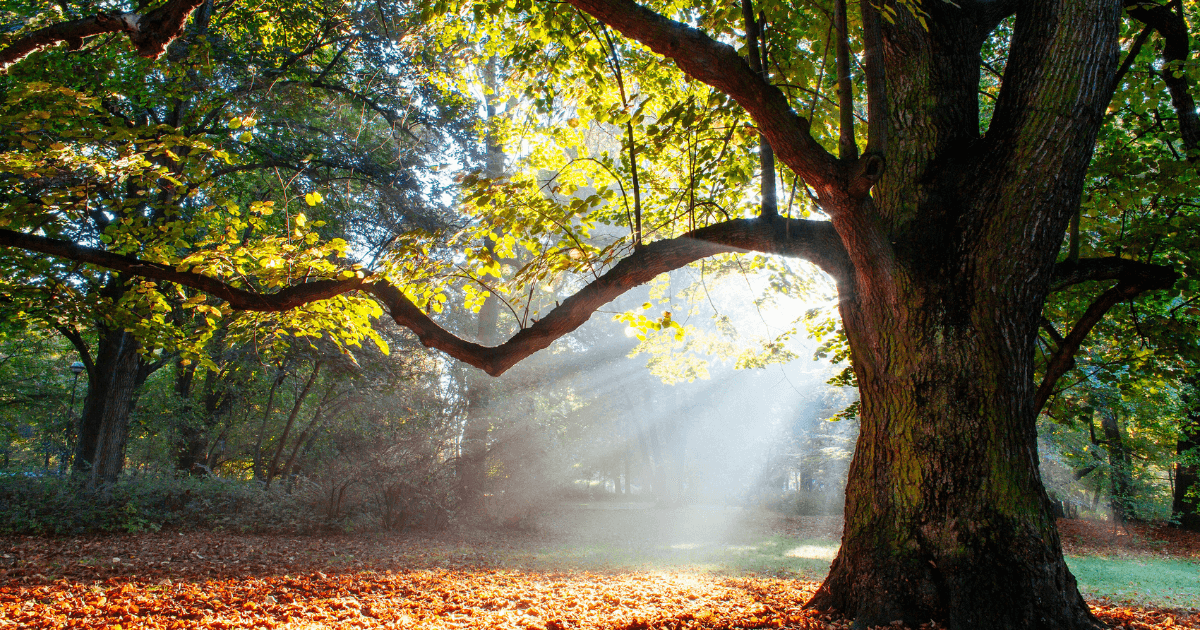
1) Pin Oak (Quercus palustris): Leaf Description and Identification
Pin Oak leaves are a spectacle in the world of oak tree leaves. They’re usually 3-6 inches long with 5-7 lobes with pointed tips. The leaf’s upper surface is a shiny dark green, while the lower surface is a lighter green. The leaf matures into a deep yellowish-red color, adding to the visual charm of this oak species. Pin Oaks also produce acorns, just like other oaks.
2) Northern Red Oak (Quercus rubra): Leaf Description and Identification
Northern Red Oak, a common species in North America, has unique leaf features. The leaves of this tree are oblong to elliptic, with a deep green shine on the sun-exposed surface and dull white hairs on the underside. They are 4-8 inches long and 4-6 inches wide, with 2-4 dominant lobes, each with 2-3 bristle-pointed tips.
The leaves are about 5-8″ long and 2.5-6″ across. They have 7 to 11 pointed lobes that are sharply pointed at the tips. The fall foliage is reddish-brown. The fruits are acorns that are rounded and large. The northern red oak is native to Eastern North America and is found throughout the Piedmont and mountain areas of North Carolina.
3) White Oak (Quercus alba): Leaf Description and Identification
The leaves of the White Oak are elliptic in shape, with rounded or fingerlike lobes. They are green on the top with a lighter underside and range from 4 to 7 inches long. Each leaf comprises seven to ten rounded lobes, some of which have a finger-like appearance. The bark of the White Oak is light ashy gray, with a scaly texture and vertical blocks and scales.
The male flowers are long and showy, forming in catkins, while the female flowers are inconspicuous. The fruit of the White Oak is a brown acorn, measuring 3/4 to 1 inch in length, with a lumpy cap that covers 1/4 to 1/3 of the nut.
4) Black Oak (Quercus velutina): Leaf Description and Identification
The black oak tree bears leaves that are arranged alternately on the twig. These leaves measure 10-20 cm (4-8 in) in length and display 5-7 lobes tipped with bristles. Notably, these lobes are separated by deep U-shaped notches.
The upper surface of the leaf exhibits a lustrous deep green color, while the lower surface appears yellowish-brown. Additionally, the underside of the leaf is adorned with clumps of stellate hairs.
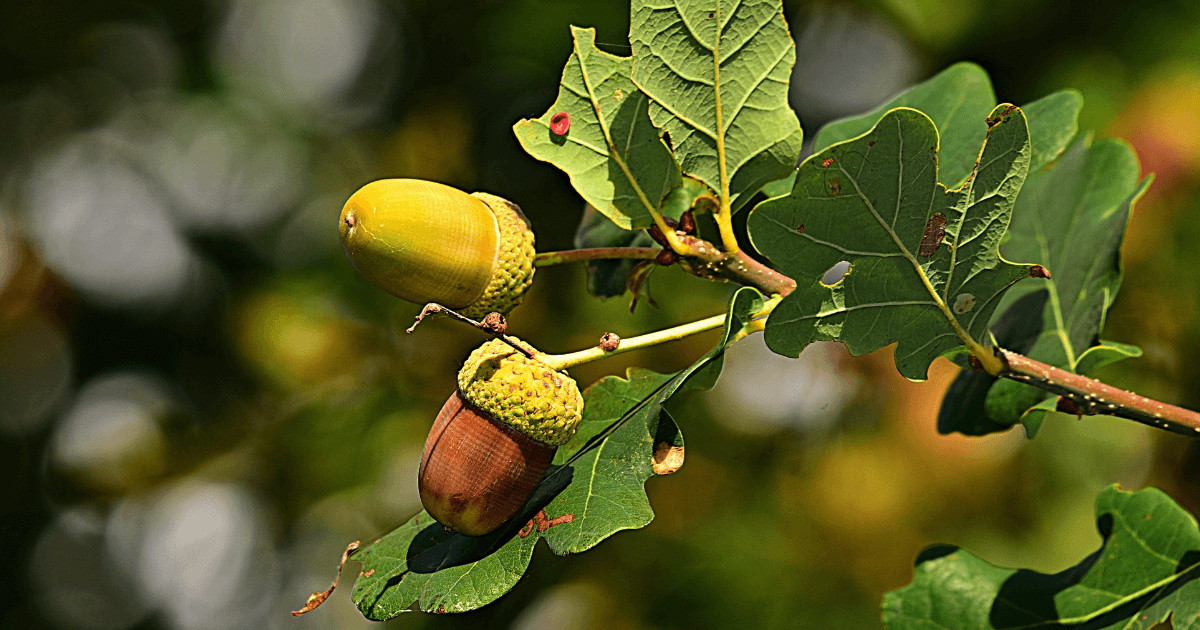
5) Burr Oak (Quercus macrocarpa): Leaf Description and Identification
The leaves of the Burr Oak tree are approximately 25 cm (10 inches) long. They have a dark green and shiny upper surface, while the lower surface is dull and whitish. Each leaf is divided into two parts – a wide upper half and a narrow lower part, separated by two deep sinuses.
The leaves have 5 to 9 rounded lobes with sinuses below the middle. On the lower surface, there are white hairs. The Burr Oak tree is also known as the mossy-cup oak because its acorn cups are heavily fringed.
6) Swamp White Oak (Quercus bicolor): Leaf Description and Identification
The leaves of the swamp white oak exhibit a distinctive two-toned coloration. The upper half displays a glossy, medium to dark green shade, while the undersides appear silvery white with a tomentose texture. Additionally, these leaves feature rounded shallow lobes adorned with coarse dentate teeth.
7) Scarlet Oak (Quercus coccinea): Leaf Description and Identification
The glossy green leaves of the Scarlet Oak are 7–17 cm (2.75 – 6.75 in) long and 8–13 cm (3.25 – 5 in) broad. They have seven lobes with deep sinuses between them, and each lobe is adorned with 3–7 bristle-tipped teeth.
Unlike the related pin oak (Q. palustris), the Scarlet Oak leaves are hairless, except for tufts of pale orange-brown down where the lobe veins meet the central vein. In autumn, the foliage of this tree typically turns a vibrant scarlet color.
8) Southern Red Oak (Quercus falcata): Leaf Description and Identification
The leaves of the Southern Red Oak have a shiny green color and are alternate and simple. They are typically 5 to 9 inches long and 4 to 5 inches wide, with the terminal lobe being longer and narrower than the others. During fall and winter, the leaves fall and turn brown gradually. The bark of the Southern Red Oak is dark gray to black and has some resemblance to cherry bark. Wildlife is attracted to the half-inch-diameter acorns that the tree produces.
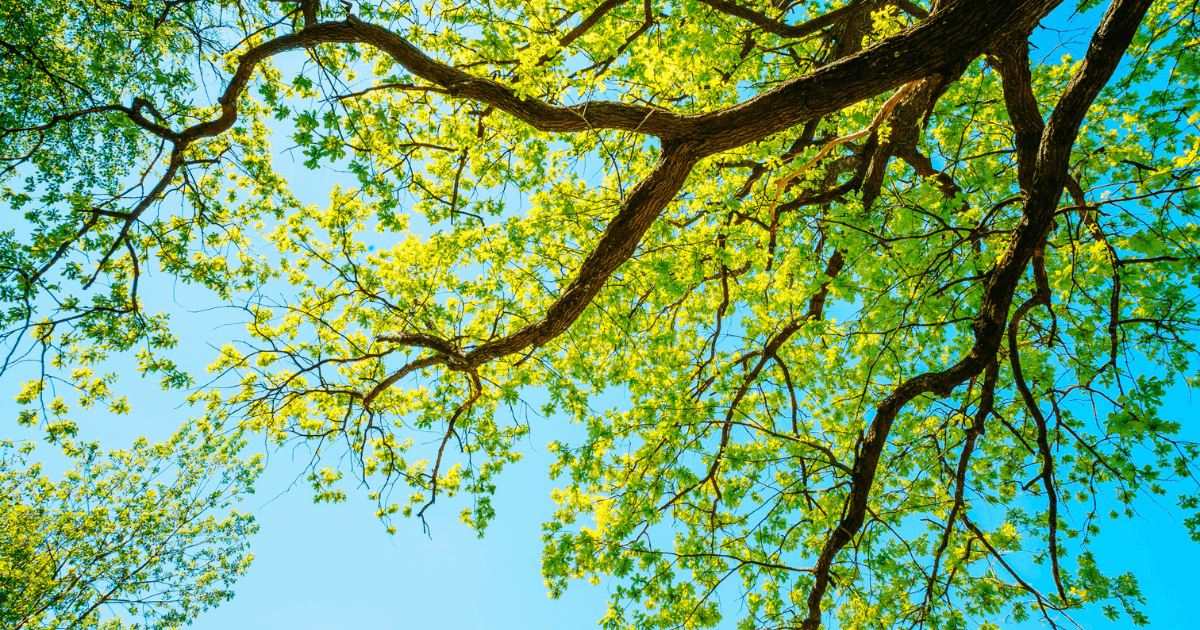
9) Cherrybark Oak (Quercus pagoda): Leaf Description and Identification
The leaves of Cherrybark Oak have a pagoda-like shape with pointed lobes resembling the outline of a Chinese pagoda. This tree can reach a height of up to 130 feet in the wild, with a straight trunk and relatively fast growth.
The leaves are glossy and dark green, turning yellow-brown in the fall before dropping. The acorns on this tree take 2 years to mature and are found on trees that are at least 25 years old. Cherrybark Oak is adaptable to drier sites in full sun to partial shade, thriving best in moist, well-drained bottomland sites. It is a versatile tree that provides shade in large areas, as a street tree, or in naturalized spaces.
10) Shingle Oak (Quercus imbricaria): Leaf Description and Identification
The leaves of the Shingle Oak are alternate, simple, oblong, or obovate, measuring four to six inches long. They have a wedge-shaped or rounded base and an acute or rounded apex. Sometimes, they may be three-lobed.
When the leaves emerge from the bud, they are bright red and covered with rusty down on the upper surface, while the lower surface is white and tomentose. At full growth, the leaves are dark green, smooth, and shiny on the upper surface and pale green or pale brown and downy on the lower surface. The leaf margin is smooth, and the underside of the leaf is bright and tomentose.
11) California Black Oak (Quercus kelloggii): Leaf Description and Identification
The leaves of this tree are typically 10-25 cm (4-9.75 in) long and deeply lobed, usually into seven portions. They are red and velvety when young, transitioning to yellow-green and then orange-brown in autumn.
The leaf shape of Quercus coccinea is reminiscent but with a deeper, lustrous green color on the top and a lighter shade underneath. The leaf base tends to be either obtuse or wedge-shaped, with the upper surface exhibiting a glossy green hue and the lower surface appearing paler.
12) Blue Oak (Quercus douglasii): Leaf Description and Identification
The leaves of the Blue Oak are tough and leathery, us
ually 4–10 cm (1.5 – 4 in) long. They are oblong or elliptic, with an obtuse apex and a broad or almost truncate base. These leaves have a blue-green color that is relatively bluer compared to other oaks.
The bark of the Blue Oak is smooth and light gray. It is a drought-tolerant deciduous oak species found in California. The acorns are typically 2–3 cm (0.75 – 1.25 in) long, with a moderately sweet kernel, and they mature within 6–7 months from pollination.

13) Oregon White Oak (Quercus garryana): Leaf Description and Identification
Lastly, let’s talk about the Oregon White Oak, scientifically known as Quercus garryana. The leaves of this oak tree are unique, with their 2-6 inch length, bristle-tipped lobes, and a shiny dark green upper surface. The leaf’s lower surface is a lighter green, giving it a lovely two-tone effect.
14) Post Oak (Quercus stellata): Leaf Description and Identification
The tree has alternate leaves with 5 lobes and a hairy, pale underside. The two middle lobes are distinctly square, giving the leaves a cruciform appearance. They usually have 5 rather squarish or rounded lobes, which are smaller at the base of the leaf and become broader near the tip. The leaves are 4 to 6 inches long and 2 to 4 inches broad. They are also quite hairy or rough, especially on the top surface.
15) Chestnut Oak (Quercus Montana): Leaf Description and Identification
The leaves of the Chestnut Oak tree are deciduous and have an oval shape that narrows at the top and bottom but is widest above the middle. The edges of the leaves are scalloped, and the surface is shiny green with a pale underside.
16) Chinquapin Oak (Quercus muehlenbergii): Leaf Description and Identification
We have the Chinquapin Oak, scientifically known as Quercus muehlenbergii. The leaves of the Chinquapin Oak are oblong and narrow at the top and bottom. The margins are coarsely scalloped or serrated, with each tooth tipped with a small gland or callus. The upper surface of the leaf is shiny green with a pale underside.
17) Water Oak (Quercus nigra): Leaf Description and Identification
Water oak leaves have an elongated or spoon-shaped appearance, ranging from 2 to 8 inches in length. They grow alternately and are simple in structure, resembling a fan with a narrow base that broadens near the tip.
Often displaying wavy edges with three distinct lobes and tipped with bristles, these leaves are a light dusty green color with softly lobed edges. While they bear a resemblance to arugula leaves, water oak leaves are larger in size. The undersides of these leaves have a slight whitish hue, while the upper side appears greenish-blue. In the autumn season, they transform into a beautiful shade of yellow.
18) Live Oak (Quercus virginiana): Leaf Description and Identification
The Live Oak tree features sprawling, twisting branches, black acorns, leathery dark green leaves, and reddish-brown furrowed bark. Its oblong, elliptical leaves are glossy green with a leathery texture. The upper surface of the leaves is shiny, while the underside has fine, grayish hairs. These thick green leaves grow alternately and measure 2 to 5 inches long and up to 1.5 inches wide.
19) Laurel Oak (Quercus laurifolia): Leaf Description and Identification
The leaves of the Laurel Oak are alternate, simple, and widest near the middle. They measure 3 to 5 inches in length and 1 to 1 1/2 inches in width, with smooth edges. The leaves are thick, persistent, shiny above, and pale and smooth below.
In spring, the tree produces inconspicuous yellow-green catkins. The Laurel Oak, also known as swamp laurel oak, diamond-leaf oak, water oak, obtusa oak, and laurel oak, is a remarkable tree.
20) Willow Oak (Quercus phellos): Leaf Description and Identification
The Willow Oak (Quercus phellos) is a native red oak with distinctive long, willow-like leathery leaves. Unlike typical oak leaves, the leaves of the willow oak lack lobes and instead have a long, slender, lance-shaped appearance that tapers at both ends. The blades of the leaves are smooth and shiny green. In the fall, they transition to russet or yellow before dropping.
21) Overcup Oak (Quercus lyrata): Leaf Description and Identification
The leaves of this tree are simply arranged in an alternating pattern, measuring an average of 15 to 20 cm (6 to 8 in) in length. They possess broad, deeply lobed shapes, resembling a lyre, and have a leathery texture. On the upper side, the leaves exhibit a dark green and glossy appearance, while the underside appears paler, with a gray-green color and fine hairs.
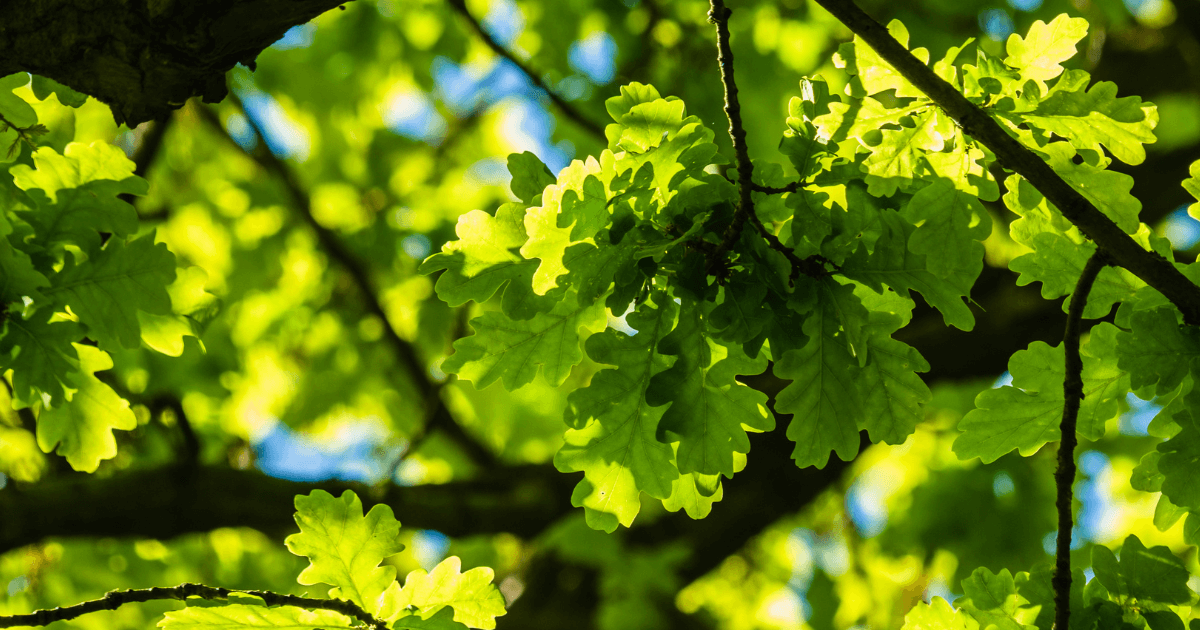
22) Sessile Oak (Quercus petraea): Leaf Description and Identification
The leaves of the Sessile Oak have lobes with a long leaf stalk and are dark olive green in color. They measure 7-14 cm in length and have 5-6 lobes on each side with a 1 cm-long petiole. The leaf margin is smooth.
23) English Oak (Quercus robur): Leaf Description and Identification
The leaves of the English Oak are arranged alternately along the twigs. They have a broad oblong or ovate shape, measuring approximately 10-12 cm in length and 7-8 cm in width. The leaves are attached to the twigs by a short petiole, typically measuring 2-3 mm.
They have a cordate (auricled) base and are divided into 3-6 rounded lobes, which do not extend beyond the midrib. The lower surface of the leaves is usually smooth, although a few simple hairs may be present.
24) Durmast Oak (Quercus petraea): Leaf Description and Identification
The Durmast Oak has yellowish-green leaves with a clearly stalked shape. Its leaves emerge two weeks later than those of the Pedunculate Oak (Quercus robur), with which it overlaps extensively in range. The leaves of the Durmast Oak are obovate to oval in shape, regularly lobed, and larger than Q. robur’s. They are leathery and often remain on the tree in a dry state during winter.
Conclusion: Simplifying Oak Tree Identification through Leaf Features
And there you have it! By focusing on the unique features of oak tree leaves, such as the number of leaf lobes, the color variations, and even peculiarities like female flowers in some species, you can identify different oak species.
Remember, trees like the Quercus robur or English Oak, and sub-groups like live oaks, all have distinctive leaf traits. So, the next time you’re out and about, take a moment to observe the leaves around you. You might just spot an oak tree that’s years old, standing tall and proud, contributing to our ecosystem in its silent, steadfast way.

